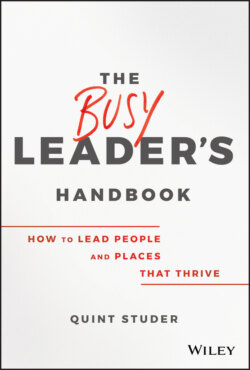The Busy Leader's Handbook

Реклама. ООО «ЛитРес», ИНН: 7719571260.
Оглавление
Quint Studer. The Busy Leader's Handbook
Praise for The Busy Leader's Handbook
THE Busy LEADER'S HANDBOOK. HOW TO LEAD PEOPLE. AND PLACES. THAT THRIVE
CONTENTS
Guide
Pages
How to Approach This Book
“Wait . . . Didn’t I Read This in Another Chapter?”
I The Leader in You: Key Skills and Behaviors
1 Strive to Be Self-Aware and Coachable
2 Invite Feedback from Others and Don’t Take It Personally; Instead, Take Ownership
Taking Ownership: Eliminating Excuses
3 To Be a Good Leader, First Learn to Be a Good Follower
The Best Leaders Actually See Themselves as Followers
Note
4 Quiet the Ego and Lead with Humility
First, Diagnose: Do You Have a Humility Problem?
5 Let Values Be Your Guide
What to Do When Asked to Go Against Values
6 Be a Good Communicator
7 Know How to Get Things Done: Hit the Brakes on the Ideas; Hit the Gas on the Execution
Note
8 Get Intentional About Time Management
Some Thoughts on Delegation
9 Grace Under Fire: How to Manage Yourself During Stressful, Busy Times
10 Change the Way You Think About Change
Don’t Let Change-Resistant People Block Progress
Note
11 Embracing Discomfort: Why Allowing Yourself to Be Unsettled Makes You a Better Leader
12 Clarity Counts: How and Why Leaders Should Give Clear Guidance on Rules
13 Face Conflict Head-on: Why Conflict Resolution Is the Ultimate Business Skill
14 Reaching Resolution: How to Have Tough Conversations Without Damaging Relationships
15 Drill Down on Generalizations
II Optimizing Employee Performance
16 Creating a Positive Workplace Culture
17 The Secret to Strong Relationships: Manage the Emotional Bank Account
Get to Know Employees Through Rounding
18 Positive Recognition Changes Everything: The Art of Rewarding, Recognizing, and Saying Thank You
Hardwiring a Thank-You Note System
19 Meaning, Purpose, and Engagement: How Great Leaders Effectively Connect All Three
What Kind of Leaders Drive a Sense of Purpose, Meaning, and Engagement?
How to Be a “Best Odds” Boss for Engaging Employees
Note
20 Help Employees Understand the Meaning of Their Work
Note
21 Psychological Safety: Making It Comfortable for People to Tell the Truth and Take Risks
Note
22 Know What the What Is for Others (and Communicate Your Own What)
23 Don’t Resort to We/Theyism; Don’t Let Others Practice It, Either
24 Create a Culture of Ownership Inside Your Company
25 Mentors Matter: Here’s How to Be One and How to Work with One
How to Be a Great Mentee
26 Reducing Workplace Drama: How It Harms Your Company and How to Shut It Down
27 Make an Effort to Become a Millennial-Friendly Leader
Note
28 Be a Positive Ambassador for Your Organization—and Teach Others to Do the Same
III Strategic/Foundational Topics
29 The Case for Structure: Why Companies Should Hardwire Processes, Practices, and Other Foundational Building Blocks
30 Define and Live Your Mission, Vision, and Values
Note
31 Set Big, Bold, Clear Goals and Communicate Them to All Employees
32 Put “Official” (Written) Standards of Behavior in Place
SAMPLE STANDARDS OF BEHAVIOR. Commitment to Coworkers
Creating a Positive Workplace
Technology Etiquette
Commitment to Clients
Communicating with Clients and Customers
33 The Power of Metrics: How Measuring the Important Things Helps Us Be the Best We Can Be
34 The Middle Manager Impact: Why a Strong Leader Development System Is Crucial
Tips for Developing Your Middle Management Team
Note
35 Hiring the Right People: Creative Ways to Recruit and Hire
A Few Things Not to Do
The Interview Process: Peer Interviewing and Behavioral-Based Questions
What to Look for in the Candidates You Interview
36 Retention: The First 90 Days and Beyond
Set the New Employee Up for Success by Showing What Success Looks Like
Keeping Your Great New Hires
37 Create a Training and Development System That Motivates Employees to Learn
Note
38 Performance Reviews That Make a Difference
39 Customer Satisfaction Starts with Employee Engagement: Have a Process to Regularly Measure Both
40 Put a Well-Run Meeting System in Place: Why a Large-Group/Small-Group Approach Often Works Best
How to Facilitate Large-Group Meetings
How to Get the Most Out of Small-Group Meetings
A Few Tips for Facilitating a Great Small-Group Meeting
41 Focus on What Right Looks Like: How to Collect and Move Best Practices
Note
A Final Thought: Putting It All into Practice
Acknowledgments
About the Author
Index
How Quint Studer Can Help Your Organization. . . and Your Community
For Organizations. .
For Communities. .
WILEY END USER LICENSE AGREEMENT
Отрывок из книги
“When deciding which companies to invest in, we definitely take a long, hard look at the executive leadership team. However, it goes much deeper than that. How they develop their middle-management team is also crucial to the long-term success of a company. Sometimes, this transfer of knowledge is where companies struggle. This book is not only a great playbook for CEOs, but it would be a very effective tool for creating a strong leadership framework throughout their entire organization. It's a simple, easy read, filled with tactics that could create a strong leadership foundation in any company.”
—Charles Dieveney
.....
“I have read a lot of leadership books over the years and this one might be my favorite. It is a simple, easy, practical read. Quint Studer has taken complex topics and broken them down in a way that makes them feel doable. (This is Quint's gift!) I also think he did a smart thing by not making this a cover-to-cover narrative—if you're struggling in a certain area you can just go to the table of contents and then flip to the needed chapter. Whether you are new to leadership or need a gentle reminder of what ‘right' looks like, this is a must-read handbook for everyone in your organization.”
—Ben Bates
.....